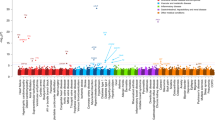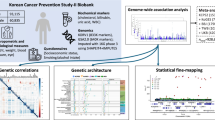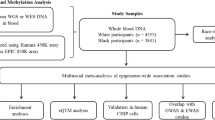Abstract
Genetic studies in isolated populations often increase power for identifying loci associated with complex diseases and traits. We present here the Kibbutzim Family Study (KFS), aimed at investigating the genetic basis of cardiometabolic traits in extended Israeli families characterized by long-term social stability and a homogeneous environment. Extensive information on cardiometabolic traits, as well as genome-wide genotypes, were collected on 901 individuals. We observed that most KFS participants were of Ashkenazi Jewish (AJ) genetic origin, confirmed a recent severe bottleneck in the AJ recent history, and detected a subtle within-AJ population structure. Focusing on genetic variants relatively common in the KFS but very rare in Europeans, we observed that AJ-enriched variants appear in cancer-related pathways more than expected by chance. We conducted an association study of the AJ-enriched variants against 16 cardiometabolic traits, and found seven loci (24 variants) to be significantly associated. The strongest association, which we also replicated in an independent study, was between a variant upstream of MSRA (frequency ≈1% in the KFS and nearly absent in Europeans) and weight (P = 3.6∙10-8). In conclusion, the KFS is a valuable resource for the study of the population genetics of Israel as well as the genetics of cardiometabolic traits.
Similar content being viewed by others
Log in or create a free account to read this content
Gain free access to this article, as well as selected content from this journal and more on nature.com
or
References
Kristiansson K, Naukkarinen J, Peltonen L. Isolated populations and complex disease gene identification. Genome Biol. 2008;9:109.
Zeggini E, Gloyn AL, Hansen T. Insights into metabolic disease from studying genetics in isolated populations: stories from Greece to Greenland. Diabetologia. 2016;59:938–41.
Fang S, Zhang S, Sha Q. Literature reviews on methods for rare variant association studies. Hum Genet Embryol. 2016;6:1–5.
Guha S, Rosenfeld Ja, Malhotra AK, et al. Implications for health and disease in the genetic signature of the Ashkenazi Jewish population. Genome Biol. 2012;13:R2.
Kenny EE, Pe’er I, Karban A, et al. A genome-wide scan of Ashkenazi Jewish crohn’s disease suggests novel susceptibility loci. PLoS Genet. 2012;8:1–10. [cited 26 Oct 2017]
Charrow J. Ashkenazi Jewish genetic disorders. Fam Cancer. 2004;3:201–6. [cited 26 Oct 2017]
Vacic V, Ozelius LJ, Clark LN, et al. Genome-wide mapping of IBD segments in an Ashkenazi PD cohort identifies associated haplotypes. Hum Mol Genet. 2014;23:4693–702. [cited 3 Dec 2017]
Lencz T, Guha S, Liu C, et al. Genome-wide association study implicates NDST3 in schizophrenia and bipolar disorder. Nat Commun. 2013;4:2739.
Slatkin M. A population-genetic test of founder effects and implications for Ashkenazi Jewish diseases. Am J Hum Genet. 2004;75:282–93. [cited 3 Dec 2017]
Risch N, Tang H, Katzenstein H, Ekstein J. Geographic distribution of disease mutations in the Ashkenazi Jewish population supports genetic drift over selection. Am J Hum Genet. 2003;72:812–22. [cited 3 Dec 2017]
Rivas MA, Avila BE, Koskela J, et al. Insights into the genetic epidemiology of Crohn’s and rare diseases in the Ashkenazi Jewish population, T2D-GENES Consortium. PLoS Genet. 2018;14:e1007329. [cited 22 Jun 2018]
Carmi S, Hui KY, Kochav E, et al. Sequencing an Ashkenazi reference panel supports population-targeted personal genomics and illuminates Jewish and European origins. Nat Commun. 2014;5:4835.
Zeevi D, Bloom JS, Sadhu MJ, et al. Analysis of the genetic basis of height in large Jewish nuclear families. bioRxiv. 1–17. [cited 20 Apr 2018]
Mathers CD, Loncar D. Projections of global mortality and burden of disease from 2002 to 2030. PLoS Med. 2006;3:2011–30. [cited 2 Nov 2017]
Fall T, Ingelsson E. Genome-wide association studies of obesity and metabolic syndrome. Mol Cell Endocrinol. 2014;382:740–57. [cited 26 Oct 2017].
Atanasovska B, Kumar V, Fu J, Wijmenga C, Hofker MH. GWAS as a driver of gene discovery in cardiometabolic diseases. Trends Endocrinol Metab. 2015;26:722–32. [cited 26 Oct 2017]
Friedlander Y, Kark JD, Sinnreich R, Tracy RP, Siscovick DS. Fibrinogen and CRP in Israeli families: genetic and environmental sources of concentrations and longitudinal changes. Atherosclerosis. 2006;189:169–77. [cited 18 Dec 2012]
Friedlander Y, Vatta M, Sotoodehnia N, et al. Possible association of the human KCNE1 (minK) gene and QT interval in healthy subjects: evidence from association and linkage analyses in Israeli families. Ann Hum Genet. 2005;69(Pt 6):645–56. [cited 18 Dec 2012]
Lemaitre RN, Siscovick DS, Berry EM, Kark JD, Friedlander Y. Familial aggregation of red blood cell membrane fatty acid composition: the Kibbutzim Family Study. Metabolism. 2008;57:662–8. [cited 18 Dec 2012]
Friedlander Y, Elkana Y, Sinnreich R, Kark JD. Genetic and environmental sources of fibrinogen variability in Israeli families: the Kibbutzim Family Study. Am J Hum Genet. 1995;56:1194–206.
Ott J, Kamatani Y, Lathrop M. Family-based designs for genome-wide association studies. Nat Rev Genet. 2011;12:465–74.
Friedlander Y, Lapidos T, Sinnreich R, Kark JD. Genetic and environmental sources of QT interval variability in Israeli families: the kibbutz settlements family study. Clin Genet. 1999;56:200–9.
Friedlander Y, Kark JD, Sinnreich R, Basso F, Humphries SE. Combined segregation and linkage analysis of fibrinogen variability in Israeli families: evidence for two quantitative-trait loci, one of which is linked to a functional variant (-58G>A) in the promoter of the alpha-fibrinogen gene. Ann Hum Genet. 2003;67(Pt 3):228–41.
Friedlander Y, Kark JD, Sinnreich R, Edwards KL, Austin MA. Inheritance of LDL peak particle diameter: results from a segregation analysis in Israeli families. Genet Epidemiol. 1999;16:382–96.
Sinnreich R, Friedlander Y, Luria MH, Sapoznikov D, Kark JD. Inheritance of heart rate variability: the kibbutzim family study. Hum Genet. 1999;105:654–61.
Sinnreich R, Friedlander Y, Sapoznikov D, Kark JD. Familial aggregation of heart rate variability based on short recordings--the kibbutzim family study. Hum Genet. 1998;103:34–40.
Chang CC, Chow CC, Tellier LC, Vattikuti S, Purcell SM, Lee JJ. Second-generation PLINK: rising to the challenge of larger and richer datasets. Gigascience. 2015;4:7.
Conomos MP, Reiner AP, Weir BS, Thornton TA. Model-free estimation of recent genetic relatedness. Am J Hum Genet. 2016;98:127–48.
Behar DM, Metspalu M, Baran Y, et al. No evidence from genome-wide data of a Khazar origin for the Ashkenazi Jews. Hum Biol. 2013;85:859–900.
O’Connell J, Gurdasani D, Delaneau O, et al. A general approach for haplotype phasing across the full spectrum of relatedness. PLoS Genet. 2014;10:e1004234.
Gusev A, Lowe JK, Stoffel M, et al. Whole population, genome-wide mapping of hidden relatedness. Genome Res. 2009;19:318–26.
Durand EY, Eriksson N, Mclean CY. Reducing pervasive false-positive identical-by-descent segments detected by large-scale pedigree analysis. Mol Biol Evol. 2014;31:2212–22.
Howie B, Fuchsberger C, Stephens M, Marchini J, Abecasis GR. Fast and accurate genotype imputation in genome-wide association studies through pre-phasing. Nat Genet. 2012;44:955–9.
Palamara PF, Lencz T, Darvasi A, Pe’er I. Length distributions of identity by descent reveal fine-scale demographic history. Am J Hum Genet. 2012;91:809–22.
Hatzikotoulas K, Gilly A, Zeggini E. Using population isolates in genetic association studies. Brief Funct Genom. 2014;13:371–7.
Lek M, Karczewski KJ, Minikel EV, et al. Analysis of protein-coding genetic variation in 60,706 humans. Nature. 2016;536:285–91.
Auton A, Abecasis GR, Altshuler DM, et al. A global reference for human genetic variation. Nature. 2015;526:68–74.
Cingolani P, Platts A, Wang LL, et al. A program for annotating and predicting the effects of single nucleotide polymorphisms, SnpEff: SNPs in the genome of Drosophila melanogaster strainw1118; iso-2; iso-3. Fly (Austin). 2012; 6(2):80-92.
Subramanian A, Tamayo P, Mootha VK, et al. Gene set enrichment analysis: A knowledge-based approach for interpreting genome-wide expression profiles. PNAS. 2005;102:15545–50. [cited 23 Nov 2017]
Loh P-R, Tucker G, Bulik-Sullivan BK, et al. Efficient Bayesian mixed-model analysis increases association power in large cohorts. Nat Genet. 2015;47:284–90.
Loh P-R, Bhatia G, Gusev A, et al. Contrasting genetic architectures of schizophrenia and other complex diseases using fast variance-components analysis. Nat Genet. 2015;47:1385–92.
Cui JS, Hopper JL, Harrap SB. Antihypertensive treatments obscure familial contributions to blood pressure variation. Hypertension. 2003;41:207–10.
Gusev A, Palamara PF, Aponte G, et al. The architecture of long-range haplotypes shared within and across populations. Mol Biol Evol. 2012;29:473–86.
Rowntree C, Duke V, Panayiotidis P, et al. Deletion analysis of chromosome 13q14.3 and characterisation of an alternative splice form of LEU1 in B cell chronic lymphocytic leukemia. Leukemia. 2002;16:1267–75. [cited 26 Oct 2017]
Lawrence GM, Siscovick DS, Calderon-Margalit R, et al. Cohort profile: The Jerusalem perinatal family follow-up study. Int J Epidemiol. 2015;45:343–52.
Weinryb BD. The Jews of Poland; a social and economic history of the Jewish community in Poland from 1100 to 1800. Jewish Publication Society of America; 1972. Chapter 1.
Feder J, Ovadia O, Glaser B, Mishmar D. Ashkenazi Jewish mtDNA haplogroup distribution varies among distinct subpopulations: lessons of population substructure in a closed group. Eur J Hum Genet. 2007;15:498–500. [cited 25 Jan 2018]
Costa MD, Pereira JB, Pala M, et al. A substantial prehistoric European ancestry amongst Ashkenazi maternal lineages. Nat Commun. 2013;4:1–10. [cited 25 Jan 2018]
Ng MCY, Graff M, Lu Y, et al. Discovery and fine-mapping of adiposity loci using high density imputation of genome-wide association studies in individuals of African ancestry: African Ancestry Anthropometry Genetics Consortium. Copenhaver GP, editor. PLOS Genet. 2017;13:e1006719. Apr 21 [cited 23 Oct 2017]
Han E, Carbonetto P, Curtis RE, et al. Clustering of 770,000 genomes reveals post-colonial population structure of North America. Nat Commun. 2017;8:14238. [cited 22 Jun 2018]
Zeggini E. Europe PMC funders group next-generation association studies for complex traits. Nat Genet. 2012;43:287–8.
Peltonen L, Palotie A, Lange K. Use of population isolates for mapping complex traits. Nat Rev Genet. 2000;1:182–90.
Levy-Lahad E, Catane R, Eisenberg S, Kaufman B, et al. Founder BRCA1 and BRCA2 mutations in Ashkenazi Jews in Israel: frequency and differential penetrance in ovarian cancer and in breast-ovarian cancer families. Am J Hum Genet. 1997;60:1059–67.
Streicher SA, Klein AP, Olson SH, et al. Impact of sixteen established pancreatic cancer susceptibility loci in American jews. Cancer Epidemiol Biomark Prev. 2017;10:1540–8. [cited 7 Dec 2017]
Lynch HT, Rubinstein WS, Locker GY. Cancer in Jews: introduction and overview. Fam Cancer. 2004;3:177–92. [cited 7 Dec 2017].
Feldman GE. Do Ashkenazi Jews have a higher than expected cancer burden? Implications for cancer control prioritization efforts. Isr Med Assoc J. 2001;3:341–6.
Scherag A, Dina C, Hinney A, et al. Two new loci for body-weight regulation identified in a joint analysis of genome-wide association studies for early-onset extreme obesity in French and German study groups. PLoS Genet. 2010;6:2–11.
Lindgren CM, Heid IM, Randall JC, et al. Genome-wide association scan meta-analysis identifies three loci influencing adiposity and fat distribution. PLoS Genet. 2009;5:e1000508.
Polasek O, Marusić A, Rotim K, et al. Genome-wide association study of anthropometric traits in Korcula Island, Croatia. Croat Med J. 2009;50:7–16. [cited 26 Oct 2017]
Kang SJ, Chiang CWK, Palmer CD, et al. Genome-wide association of anthropometric traits in African- and African-derived populations. Hum Mol Genet. 2010;19:2725–38. [cited 26 Oct 2017]
Parsa A, Chang YPC, Kelly RJ, et al. Hypertrophy-associated polymorphisms ascertained in a founder cohort applied to heart failure risk and mortality. Clin Transl Sci. 2011;4:17–23. [cited 26 Oct 2017]
Ober C, Nord AS, Thompson EE, et al. Genome-wide association study of plasma lipoprotein(a) levels identifies multiple genes on chromosome 6q. J Lipid Res. 2009;50:798–806.
Kettunen J, Demirkan A, Würtz P, et al. Genome-wide study for circulating metabolites identifies 62 loci and reveals novel systemic effects of LPA. Nat Commun. 2016;7:11122.
Acknowledgements
We are grateful to the study participants, recruiters, interviewers, and nurses. This study was supported by Israeli Science Foundation grants 201/98-1 and 407/17 and partially by National Institutes of Health research grant R01HL088884. Genotyping was also supported in part by a generous gift from the Samson Family (South Africa) to DK.
Author information
Authors and Affiliations
Corresponding authors
Ethics declarations
Conflict of interest
The authors declare that they have no conflict of interest.
Electronic supplementary material
Rights and permissions
About this article
Cite this article
Granot-Hershkovitz, E., Karasik, D., Friedlander, Y. et al. A study of Kibbutzim in Israel reveals risk factors for cardiometabolic traits and subtle population structure. Eur J Hum Genet 26, 1848–1858 (2018). https://doi.org/10.1038/s41431-018-0230-3
Received:
Revised:
Accepted:
Published:
Issue date:
DOI: https://doi.org/10.1038/s41431-018-0230-3
This article is cited by
-
Genome wide association study and genomic risk prediction of age related macular degeneration in Israel
Scientific Reports (2024)
-
A prospective clinical cohort-based study of the prevalence of OCD, obsessive compulsive and related disorders, and tics in families of patients with OCD
BMC Psychiatry (2022)
-
Admixture/fine-mapping in Brazilians reveals a West African associated potential regulatory variant (rs114066381) with a strong female-specific effect on body mass and fat mass indexes
International Journal of Obesity (2021)
-
Searching for parent-of-origin effects on cardiometabolic traits in imprinted genomic regions
European Journal of Human Genetics (2020)



